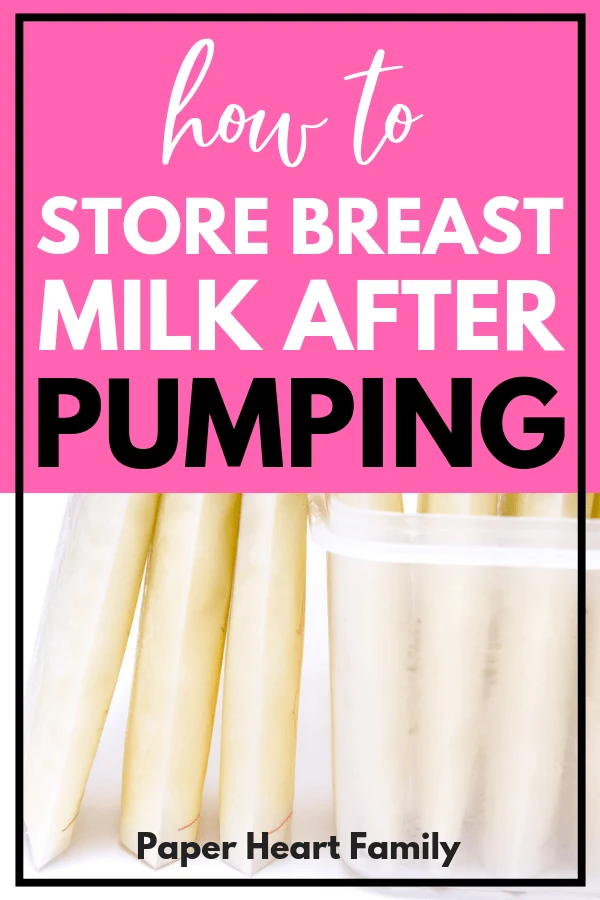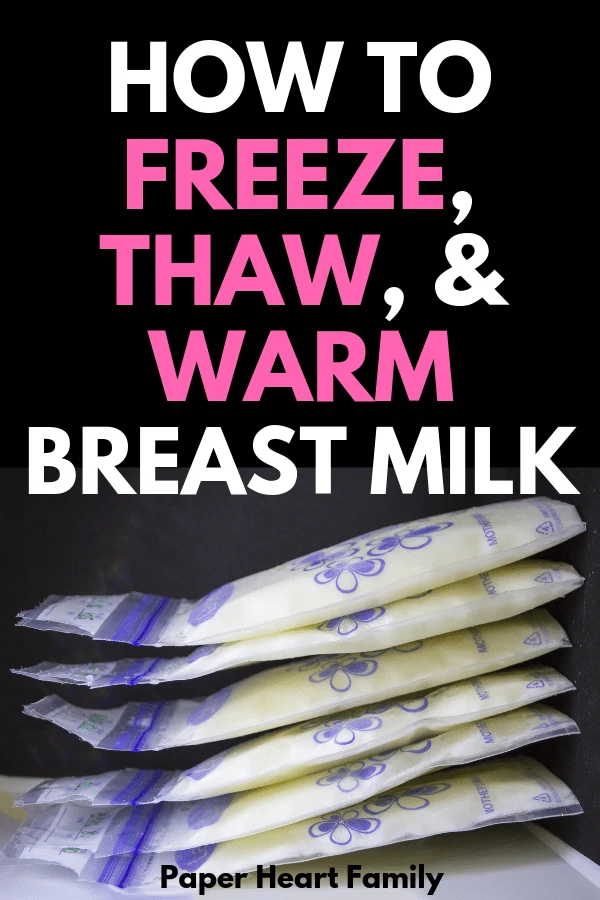Today I’m talking anything and everything about how to store breast milk after pumping. I’m sure you’re on the edge of your seat.
But in all seriousness, storing, thawing and everything that includes caring for our expressed milk is an important job and one of many pumping tips that you need to familiarize yourself with.
And besides, pumping is a lot of not-so-fun work, so knowing what to do with that milk once you’ve pumped it is important.
Unfortunately we can’t always just stick our baby on the boob and forget about appropriate refrigerating, freezing, thawing, and warming. That’s SO much easier, right?
It’s important to handle our precious liquid gold with care. Improper storage of breast milk can lead to:
- Bacterial contamination
- Milk degradation
- Decrease in nutritional value
Proper storage of your expressed milk can help you ensure that your milk is safe and nutritious for your baby.
Related: How To Bottle Feed Breast Milk
This post contains affiliate links.
How To Store Breast Milk After Pumping

Here are the breast milk storage guidelines for freshly pumped milk (source) :
Option #1- Keep at room temperature- freshly expressed milk is good at room temperature (up to 77 degrees) for 4 hours
Option #2- Refrigerate it- Breast milk is good in the refrigerator for up to 4 days
Option #3- Freeze it in quantities of 2-4 ounces
Also be sure to thoroughly wash your hands before handling your breast milk and to store it in an appropriate plastic or glass bottle with a screw-on lid or a breast milk storage bag. Write the date that the milk was pumped on the storage container along with the quantity for future reference.
Related: Sample Breastfeeding And Pumping Schedule
Storing Breast Milk Chart
At room temperature- good for 4 hours if freshly expressed milk
Refrigerated milk- good for 3-4 days if freshly expressed
Good for 24 hours if thawed, previously frozen milk
Frozen milk- good for up to 12 months in a stand-alone freezer
Good for up to 6 months in a freezer attached to a refrigerator
Breast Milk Storage Containers
When choosing the perfect breast milk storage container for you, you have three options:
- Storage bags
- Glass bottles
- Plastic bottles
Storage Bags
Breast milk storage bags are probably the most popular freezer option, and for good reason. They are inexpensive, take up little room, are thicker than other freezer bags and are sterile.
Pros of using storage bags
- They are inexpensive.
- They take up the least amount of room in the freezer.
- They do not require any washing.
- They allow for the milk to thaw very quickly (and when your baby goes from happy to starving in .2 seconds, you’ll be very glad for the quick thaw time)
Cons of using storage bags
- They could potentially rip or tear.
- They are not reusable.
Our best breast milk storage bag pick: Lansinoh Breast Milk Storage Bags
These storage bags are the most popular breast milk storage container among new moms.
I used them with both of my children, and they functioned beautifully. Though I’m sure it is possible for the bag to rip or break, I never had that happen.
How To Store Breast Milk In Bags
Getting your milk from bottle to bag can be a little tricky (we don’t wanna be crying over spilled milk!).
Here’s how to make it easy:
- Use your flange as a funnel.
- Remove as many air bubbles as possible by draping the bag off of the edge of the counter before sealing.
- Freeze flat.
Related: Breast Pump Bag Must Haves
Glass Bottles
Glass bottles are a great choice for the environmentally-conscious mom (or the mom who worries about chemicals found in plastics).
Pros of using glass bottles
- They are environmentally friendly.
- They are reusable.
- They provide for less risk of contamination.
Cons of using glass bottles
- May break or shatter.
- Require washing after every use.
- Defrosting must be done slowly in order to avoid breaking or cracking of the glass.
- They take up more room in the freezer than storage bags.
Our glass bottle pick: Mini mason jars (they’re so inexpensive!)
Plastic Bottles
When choosing plastic bottles for your breast milk storage, you will of course want to choose bottles that are BPA-free.
Pros of using plastic bottles
- They are stronger and more sturdy than storage bags and less prone to breaking than glass bottles.
- They can save you time, as you will pump into, refrigerate and freeze in the same container.
Cons of using plastic bottles
- The bottles will need to be washed after every use.
- Bottles take up more freezer space than bags.
- Overfilled bottles could burst.
Our plastic bottle pick: Medela Plastic Breast Milk Collection And Storage Bottles
How To Thaw Breast Milk

Using care when thawing and warming your breast milk will help it hold its nutritional value.
- The best way to thaw breast milk is in the refrigerator overnight.
- You can also thaw it in a bowl of warm water.
- DO NOT thaw it in a microwave or in boiling water.
- Also, avoid shaking or stirring. Swirl the milk gently in order to mix the separated fat into the milk.
- Do NOT refreeze thawed milk.
Can you thaw breast milk at room temperature?
It’s probably not a good idea. If you forget to thaw it the night before in the fridge, simply run it under warm water. It’s just as simple.
How To Store Breast Milk When Going Out
If your milk is freshly expressed right before leaving, it can be kept at room temperature for up to 4 hours. Otherwise, you can keep the milk in an insulated container with an ice pack.
How To Warm Breast Milk On The Go
If you are trying to warm breast milk on the go, there are a couple options for you.
- Run it under warm water in the restroom.
- Ask for a mug of warm water (at a restaurant for example).
- Use a bottle warmer.
Can You Freeze Refrigerated Breast Milk?
Absolutely! I never had time to freeze the milk that I pumped during the day at work, but I always tried to freeze it that night so that it was more fresh.
How To Tell If Breast Milk Is Bad
Have you ever wondered if your breast milk is bad? I mean, how would you know?
Of course you don’t want to feed your baby milk that’s spoiled.
But it can be difficult to recognize spoiled breast milk, because the composition and smell of breast milk constantly changes based on your diet and on baby’s needs.
Here’s what to look for when determining if your breast milk has gone bad.
- When swirled, the milk doesn’t recombine nicely as it should. Your milk separates as it sits. When heated and swirled, if the fatty layer remains separate or appears chunky, it’s a good idea to throw it away.
- If it smells rancid or sour, it probably is. However, when you freeze your breast milk, if you have high lipase, it is possible that your milk will have a strange smell but still be perfectly safe. (source)
Other Important Breast Milk Storage Tips
- Freeze in small quantities of 2-4 ounces to lessen waste.
- Store milk in the far back of the fridge or freezer to lesson temperature change caused by opening the door.
- As you are using frozen breast milk, use the oldest first.
- If you are combining milk from separate pumping sessions, cool both bottles in the refrigerator before combining first.

13 Best Online Childbirth Classes And Newborn Care Classes
Tuesday 18th of April 2023
[…] how to pump and store breast milk […]
When Should You Start Pumping Breast Milk For Baby?
Sunday 9th of April 2023
[…] Related: How To Store Milk After Pumping […]
Bottle Feeding Breast Milk- Who, When And How To Do It The Right Way -
Saturday 17th of November 2018
[…] Read all of my tips on how to store breast milk after pumping. […]